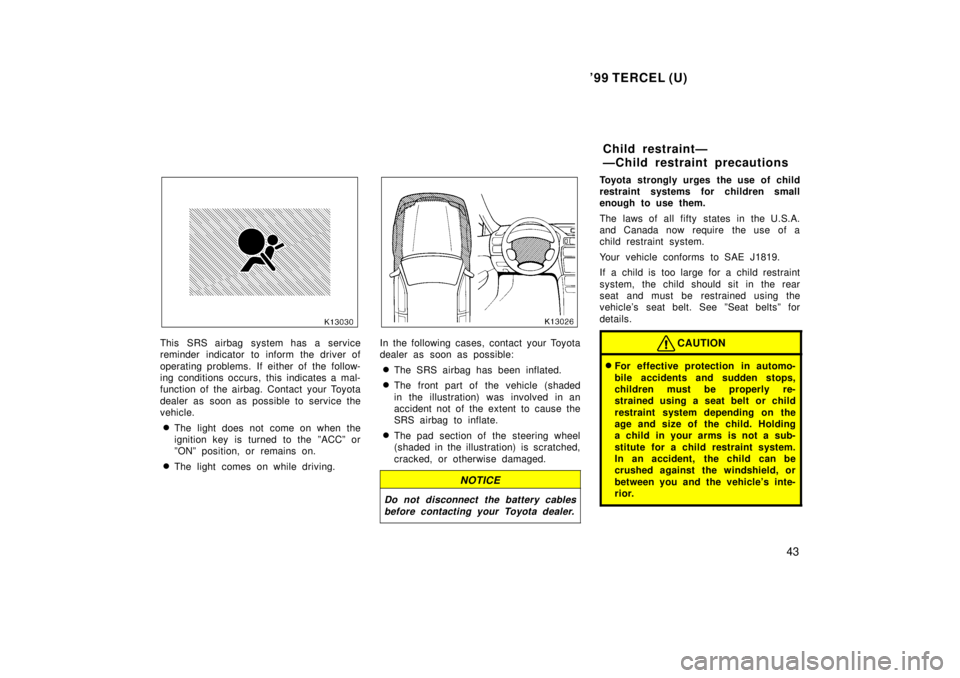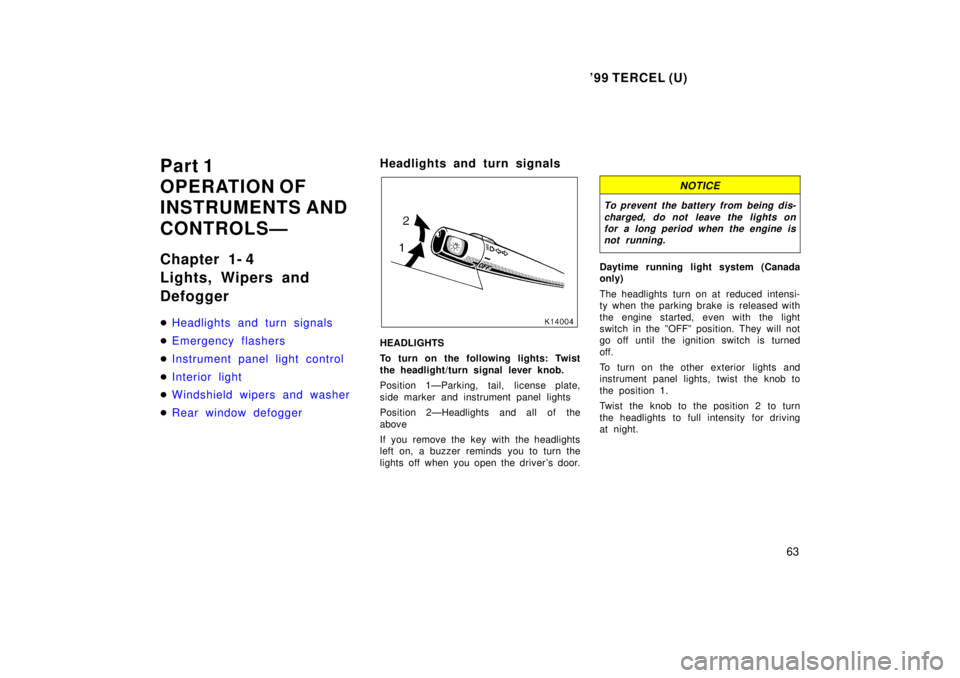1999 TOYOTA TERCEL key battery
[x] Cancel search: key batteryPage 16 of 203

'99 TERCEL (U)15
SETTING THE SYSTEM1. Turn the ignition key to the ºLOCKº position and remove it.
2. Have all passengers get out of the vehicle.
3. Close and lock all the doors, trunk and hood.
The indicator light will come on when all
the doors, trunk and hood are closed and
locked.
As the doors are locked, the system will
give you a preparation time of 30 seconds
before the setting, during which the doors,
trunk and hood may be opened. Be careful not to use the key when open-
ing either front door. This will cancel the
system.
4. After making sure the indicator light starts flashing, you may leave the ve-
hicle.
The system will automatically be set after
the preparation time passes. The indicator
light will flash to show the system is set.
If any of the doors, trunk or hood is open
at that time, the setting is interrupted until
it is closed and locked.
Never leave anyone in the vehicle when
you set the system, because unlocking
from the inside will activate the system.
WHEN THE SYSTEM IS SET
Activating the system
The system will give the alarm and cut
the starter circuit under the following
conditions: � If any of the doors, trunk or hood is
unlocked without using the key
� If the battery terminal is disconnected
and then reconnected
After one minute, the alarm will automati-
cally stop with the starter circuit cut kept on. Reactivating the alarm
Once set, the system automatically resets
the alarm each time all the doors, trunk
and hood are closed after the alarm
stops.
The alarm will be activated again under
the following conditions:
� If any of the doors, trunk or hood is opened
� If the battery terminal is disconnected
and then reconnected
Stopping the alarm
Turn the ignition key from the ºLOCKº to
ºACCº position. The alarm will be stopped
with the starter circuit cut kept on. Stop-
ping the alarm in this manner will keep
the alarm from being reactivated when any
of the doors, trunk or hood is opened.
Interrupting the setting
With the system set, the trunk can be
opened with the key without activating or
cancelling the system. While it is o pen, it
the doors and hood may be opened in
addition. However, when the battery termi-
nal is disconnected and then reconnected,
the system is activated.
To resume the setting, close and lock all
the doors, trunk and hood. The trunk must
be closed with the key removed.
Page 17 of 203

'99 TERCEL (U)
16
CANCELLING THE SYSTEM
Unlock either front door with the key. This
cancels the system completely and the
starter circuit cut will be cancelled at
once.
INDICATOR LIGHT
The indicator light gives the following
three indications.
FLASHINGÐThe system is set. You need
the key to open the doors, trunk and hood.
ONÐThe system will automatically be set
when the time comes. The doors, trunk
and hood may be opened without a key.
OFFÐThe system is inactive. You may
open any door, trunk and hood.
TESTING THE SYSTEM
1. Open all the windows.
2. Set the system as described above. The front doors should be locked with
the key. Be sure to wait until the indi-
cator light starts flashing.
3. Unlock one of the doors from the in- side. The system should activate the
alarm.
4. Cancel the system by unlocking either front door with the key. 5. Repeat this operation for the other
doors, trunk and hood. When testing on
the hood, also check that the system
is activated when the battery terminal
is disconnected and then reconnected.
If the system does not work properly,
have it checked by your Toyota dealer. Fuel tank cap
Lever type
Key type
Page 39 of 203

'99 TERCEL (U)
38
This SRS airbag system has a service
reminder indicator to inform the driver of
operating problems. If either of the
following conditions occurs, this indicates
a malfunction of the airbags. Contact your
Toyota dealer as soon as possible to
service the vehicle. � The light does not come on when the
ignition key is turned to the ºACCº or
ºONº position, or remains on.
� The light comes on while driving.In the following cases, contact your Toyota
dealer as soon as possible:
� The SRS airbags have been inflated.
� The front part of the vehicle (shaded
in the illustration) was involved in an
accident not of the extent to cause the
SRS airbags to inflate.
� The pad section of the steering wheel
or front passenger airbag cover
(shaded in the illustration) is scratched,
cracked, or otherwise damaged.
NOTICE
Do not disconnect the battery cables
before contacting your Toyota dealer.
The SRS (Supplemental Restraint Sys-
tem) airbag is designed to provide fur-
ther protection for the driver when add-
ed to the primary protection provided
by the seat belt.
In response to a severe frontal impact,
the SRS airbag works together with the
seat belt to help prevent or reduce injury
by inflating, in order to decrease the likeli-
hood of the driver 's head or chest directly
hitting the steering wheel.
Be sure to wear your seat belt. SRS driver airbag
Page 44 of 203

'99 TERCEL (U)43
This SRS airbag system has a service
reminder indicator to inform the driver of
operating problems. If either of the follow-
ing conditions occurs, this indicates a mal-
function of the airbag. Contact your Toyota
dealer as soon as possible to service the
vehicle.� The light does not come on when the
ignition key is turned to the ºACCº or
ºONº position, or remains on.
� The light comes on while driving.In the following cases, contact your Toyota
dealer as soon as possible:
� The SRS airbag has been inflated.
� The front part of the vehicle (shaded
in the illustration) was involved in an
accident not of the extent to cause the
SRS airbag to inflate.
� The pad section of the steering wheel
(shaded in the illustration) is scratched,
cracked, or otherwise damaged.
NOTICE
Do not disconnect the battery cables
before contacting your Toyota dealer.
Toyota strongly urges the use of child
restraint systems for children small
enough to use them.
The laws of all fifty states in the U.S.A.
and Canada now require the use of a
child restraint system.
Your vehicle conforms to SAE J1819.
If a child is too large for a child restraint
system, the child s hould sit in the rear
seat and must be restrained using the
vehicle's seat belt. See ºSeat beltsº for
details.
CAUTION
� For effective protection in automo-
bile accidents and sudden stops,
children must be properly re-
strained using a seat belt or child
restraint system depending on the
age and size of the child. Holding
a child in your arms is not a sub-
stitute for a child restraint system.
In an accident, the child can be
crushed against the windshield, or
between you and the vehicle's inte-
rior.
Child restraintÐ
ÐChild restraint precautions
Page 64 of 203

'99 TERCEL (U)63
Part 1
OPERATION OF
INSTRUMENTS AND
CONTROLSÐ
Chapter 1- 4
Lights, Wipers and Defogger �
Headlights and turn signals
�Emergency flashers
�Instrument panel light control
�Interior light
�Windshield wipers and washer
�Rear window defogger
Headlights and turn signals
HEADLIGHTS
To turn on the following lights: Twist
the headlight/turn signal lever knob.
Position 1ÐParking, tail, license plate,
side marker and instrument panel lights
Position 2ÐHeadlights and all of the
above
If you remove the key with the headlights
left on, a buzzer reminds you to turn the
lights off when you open the driver 's door.
NOTICE
To prevent the battery from being dis-
charged, do not leave the lights onfor a long period when the engine is not running.
Daytime running light system (Canada
only)
The headlights turn on at reduced intensi-
ty when the parking brake is released with
the engine started, even with the light
switch in the ºOFFº position. They will not
go off until the ignition switch is turned
off.
To turn on the other exterior lights and
instrument panel lights, twist the knob to
the position 1.
Twist the knob to the position 2 to turn
the headlights to full intensity for driving
at night.
Page 68 of 203

'99 TERCEL (U)67
Rear window defogger
To defog or defrost the rear window,
push the switch.
The key must be in the ºONº position.
The thin heater wires on the inside of the
rear window will quickly clear the surface.
An indicator light will illuminate to indicate
the defogger is operating.
Push the switch once again to turn the
defogger off.
With timer: The system will automatically
shut off after the defogger has operated
about 15 minutes.
Make sure you turn the defogger off when
the window is clear. Leaving the defogger
on for a long time could cause the battery
to discharge, especially during stop- and-
go driving. The defogger is not designed
for drying rain water or for melting snow.
NOTICE
�Without timer: To prevent the bat-
tery from discharged, turn theswitch on when the engine is run-ning.
�When cleaning the inside of the
rear window, be careful not toscratch or damage the heater wires.
Page 74 of 203

'99 TERCEL (U)73
(c) Front Passenger 's Seat Belt Re-
minder Light
The light remind you to buckle up the
driver 's seat belt.
Once the ignition key is turned to ºONº or
ºSTARTº, the reminder light flashes if a
passenger sits in the front passenger seat
and the front passenger 's seat belt is not
pulled out. Unless the front passenger
starts to pull the shoulder belt out of the
retractor, the light keeps flashing.
If luggage load is placed on the front
passenger seat, depending on its weight
and how it is placed on the seat, built- in
sensors in the seat cushion may detect
the pressure, causing the reminder light to
come on.
(d) Discharge Warning Light
This light warns that the battery is being
discharged.
If it comes on while you are driving, there
is a problem somewhere in the charging
system.
The engine ignition will continue to oper-
ate, however, until the battery is dis-
charged. Turn off the air conditioning,
blower, radio,etc., and drive directly to the
nearest Toyota dealer or repair shop.
NOTICE
Do not continue driving if the engine drive belt is broken or loose.
(e) Low Oil Pressure Warning Light
This light warns that the engine oil pres-
sure is too low.
If it flickers or stays on while you are
driving, pull off the road to a safe place
and stop the engine immediately. Call a
Toyota dealer or qualified repair shop for
assistance.
The light may occasionally flicker when
the engine is idling or it may come on
briefly after a hard stop. There is no
cause for concern if it then goes out when
the engine is accelerated slightly.
The light may come on when the oil level
is extremely low. It is not designed to
indicate low oil level, and the oil level
must be checked using the level dipstick.
NOTICE
Do not drive the vehicle with the
warning light onÐeven for one block.It may ruin the engine.
(f) Malfunction Indicator Lamp
This lamp comes on in the following
cases.
a. The fuel tank is completely empty. (See
ºFuel gaugeº in Chapter 1- 5 for instruc-
tions.)
b. The fuel tank cap is not tightened se-
curely. (See ºFuel tank capº in Chapter
1- 2 for instructions.)
c. There is a problem somewhere in your
engine or automatic transmission electrical
system.
If it comes on while you are driving in
case b, have your vehicle checked/re-
paired by your Toyota dealer as soon as
possible.
(g) ºABSº Warning Light
This light warns that there is a problem
somewhere in your anti- lock brake sys-
tem.
If the light comes on while you are driv-
ing, have your vehicle checked by your
Toyota dealer as soon as possible.
The light will come on when the ignition
key is turned to the ºONº position. After
a few seconds, the light will go off.
Page 76 of 203

'99 TERCEL (U)75
Part 1
OPERATION OF
INSTRUMENTS AND
CONTROLSÐ
Chapter 1- 6
Ignition switch,
Transmission and
Parking brake �
Ignition switch with steering lock
�Automatic transmission
�Manual transmission
�P ar k ing br ak e
ºSTARTºÐStarter motor on. The key
will return to the ºONº position when
released.
For starting tips, see Part 3.
ºONºÐEngine on and all accessories on.
This is the normal driving position.
ºACCºÐAccessories such as the radio
operate, but the engine is off.
If you leave the key in the ºACCº or
ºLOCKº position and open the driver's
door, a buzzer will remind you to remove
the key.
ºLOCKºÐEngine is off and the steering
wheel is locked. The key can be re-
moved only at this position.
You must push in the key to turn the key
from ºACCº to the ºLOCKº position. On
vehicles with an automatic transmission,
the selector lever must be in the ºPº posi-
tion before pushing the key.
When starting the engine, the key may
seem stuck at the ºLOCKº position. To
free it, first be sure the key is pushed all
the way in, and then rock the steering
wheel slightly while turning the key gently.
CAUTION
For manual transmission:
Never remove the key when the ve-
hicle is moving, as this will lock the
steering wheel and result in loss of
steering control.
NOTICE
Do not leave the key in the ºONº
position if the engine is not running.The battery will discharge and the
ignition could be damaged.
Ignition switch with steering
lock